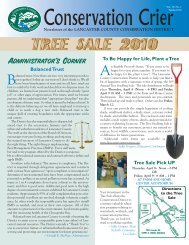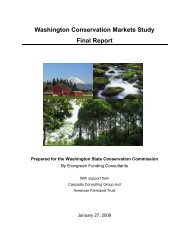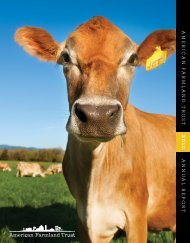Agricultural Landowners Guide Agricultural Landowners Guide
Agricultural Landowners Guide Agricultural Landowners Guide
Agricultural Landowners Guide Agricultural Landowners Guide
You also want an ePaper? Increase the reach of your titles
YUMPU automatically turns print PDFs into web optimized ePapers that Google loves.
that qualify for federal income tax deduction according<br />
to IRC Section 170(h). This credit is equal to 25 percent<br />
of the value of the donated property interest, with a cap<br />
of $250 per acre. No more than $52,500 of the credit<br />
can be taken in a single year, and the total amount of<br />
state tax credits cannot be more than the taxpayer’s<br />
total liability for that year. The unique element of South<br />
Carolina’s credit is that any unused portion can be carried<br />
over to future years or sold to other taxpaying entities.<br />
<strong>Landowners</strong> claiming this credit should file<br />
Schedule TC-19 with their state income tax return.<br />
(For further information, contact the South Carolina<br />
Department of Revenue.)<br />
<strong>Landowners</strong> should always consult with legal and<br />
financial advisors in considering a conservation easement.<br />
South Carolina has land trusts throughout the<br />
state that accept donations of conservation easements.<br />
For information and names of your local land trusts,<br />
contact the South Carolina Land Trust Network or the<br />
Land Trust Alliance.<br />
Conservation Bank<br />
Signed into law in 2002, the South Carolina<br />
Conservation Bank provides funding for protection of<br />
natural resources through the conservation of land<br />
across the state. First funded in 2004 through the documentary<br />
stamp tax for new construction and property<br />
transfers, the bank is expected to receive between<br />
$6 million and $10 million per year to help eligible conservation<br />
organizations purchase land and conservation<br />
easements through direct grants and low-interest loans.<br />
This program is entirely voluntary, and the government<br />
will not own any more land through this program.<br />
The Conservation Bank completed its first round of<br />
funding in December 2004, awarding $11 million to<br />
protect 25,000 acres, including properties ranging from<br />
a Revolutionary War battlefield in Kershaw County to<br />
family farms in Horry, Marion and Greenville counties,<br />
to a 7-acre parcel in downtown Rock Hill.<br />
Applications and ranking criteria are available online.<br />
Final funding decisions are made by a 12-member<br />
HORRY AND MARION SOIL AND WATER CONSERVATION DISTRICTS<br />
When visitors to the South Carolina coast think of<br />
Marion and Horry counties, their vision is often of golf<br />
courses and hotels along Myrtle Beach. Local USDA<br />
Natural Resources Conservation Services (NRCS) District<br />
Conservationists Rebecca Harper and Alex Johnson see a<br />
whole different side of the landscape, and they’re determined<br />
to do whatever they can to keep it that way.<br />
Though commercial and residential development pressures<br />
remain strong, Horry County’s agricultural production<br />
continues to be an important part of its environmental<br />
and economic life, with 188,000 acres in farms, and leading<br />
the state in tobacco sales (and second in hogs).<br />
Marion County, the third leading tobacco county in South<br />
Carolina, isn’t far behind. Threats to water quality are<br />
tremendous, and the efforts of private landowners are<br />
crucial to protecting natural resources.<br />
“Farmers are being offered enormous amounts of money<br />
to develop their land,” says Harper. “Anyone staying in<br />
agriculture has a love<br />
for what they’re doing,<br />
and we need to find<br />
ways to support them.<br />
They want to find ways<br />
to be sure these farms<br />
are here for their<br />
grandchildren.”<br />
<strong>Landowners</strong> in both counties have participated heavily in<br />
two NRCS programs. Marion County has 11 farms covering<br />
2,068 acres enrolled in the Wetlands Reserve Program,<br />
while Horry County has six farms and 944.7 acres.<br />
“Duck hunting is big business in this part of the state, and<br />
these programs make sense for landowners interested in<br />
improving wildlife habitat,” says Johnson.<br />
For the Farm and Ranch Lands Protection Program<br />
(FRPP), Horry has six farms enrolled with two more<br />
pending, while Marion has two pending.<br />
These two local conservation districts have been the primary<br />
partners for the FRPP in South Carolina. “The Soil<br />
and Water Conservation District has farmers lined up and<br />
waiting to sell their development rights,” says Harper.<br />
“The Marion and Horry SWCD submitted 39 parcels to<br />
the NRCS FRPP this year. Their requested program funding<br />
was over $17.7 million though the entire state allocation<br />
was only $1.3 million.”<br />
The newly funded South Carolina Conservation Bank has<br />
and will continue to be a big help in providing the necessary<br />
local matching funds to participate in the FRPP. In<br />
the first round of funding in November 2004, the Bank<br />
helped in providing the necessary local matching funds to<br />
participate in programs to protect farmland from four<br />
farms totaling 1,120 acres in Horry and Marion counties.<br />
4<br />
Photo: Clemson University Public Service and Agriculture


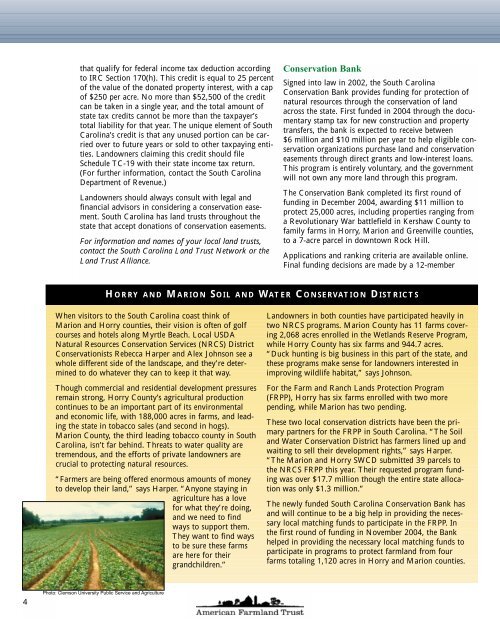
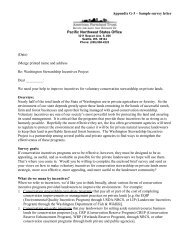


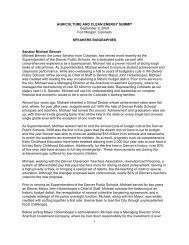
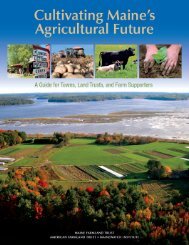
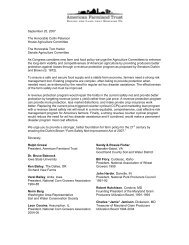
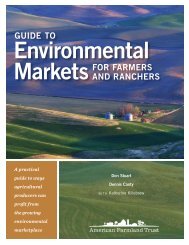
![Farmland by the Numbers [PDF] - American Farmland Trust](https://img.yumpu.com/31549391/1/190x245/farmland-by-the-numbers-pdf-american-farmland-trust.jpg?quality=85)


